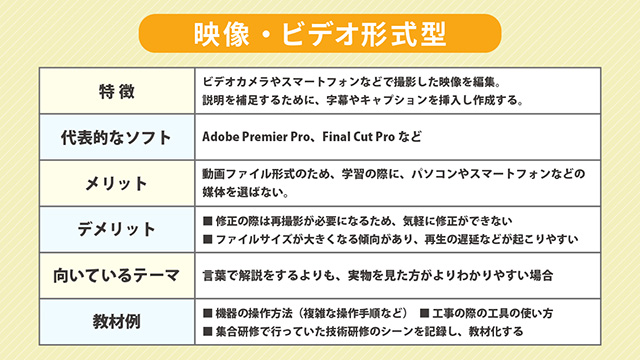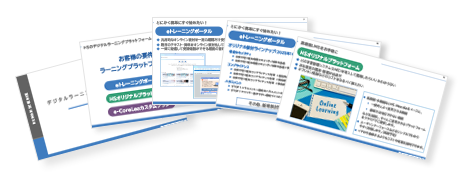2023.09.20
2024.10.08
Introduction to the points and benefits of creating e-learning videos by type

The combination of e-learning and video materials is one of the methods that can be expected to achieve higher learning effectiveness.
The compatibility of e-learning, which provides interactive learning, and video materials, which allow for intuitive grasping of abundant information, is excellent and contributes to increasing learners' motivation and improving their understanding.
This blog explores the appeal of video teaching materials from a multifaceted perspective, including the benefits of using video materials, types of materials, and points to consider when creating them. I would like to delve into the possibilities of "e-learning x video teaching materials."
*In this blog, the term "video" refers to all types of moving images, including motion graphics and slideshows, in addition to live-action.
Table of Contents
1. Background of the Proliferation of Video Materials in e-Learning
2. Benefits of Using Video Materials
3. Genres Where Learning Effects Can Be Expected with Video Materials
4. There Are Three Main Types of Video Materials
5. Key Points When Creating Video Materials for e-Learning
6. Conclusion
1. Background of the Proliferation of Video Materials in e-Learning
Various factors have influenced the background of the use of video materials in e-learning. Below are the main ones.

(1) Internet Speed Enhancement
High-speed internet has become common, enabling high-quality video streaming. As a result, an environment has been established to effectively provide video materials in e-learning.
(2) Proliferation of mobile devices such as smartphones
The proliferation of smartphones and other devices has made it possible to learn anytime and anywhere, regardless of time or place. Video materials can be easily accessed on various mobile devices, allowing for a response to diverse learning styles of learners, leading to increased demand.
(3) The Habit of Watching Videos
With the acceleration of the internet and the proliferation of mobile devices, enjoying videos on platforms like YouTube and Netflix, as well as on social media, has become a habit, making videos an indispensable part of people's lives. As a result, the act of "learning through videos" has become more acceptable and engaging, leading to the spread and expansion of video educational materials.
(4) Increase in Tools for Creating Video Materials
Due to the demand for e-learning and the evolution of technology, there has been an increase in tools that allow for easy creation of video materials, such as built-in tools within LMS (Learning Management System) and screencasting software. As a result, video materials are now being utilized in various fields.
These factors have combined to make video materials commonly used in e-learning. Learning through video is considered a powerful tool to enhance motivation for learning, and its importance is expected to increase even further in the future.
> Related Column: What is iSpring Suite? Introducing Features, Pricing, and Benefits of Implementation
2. Benefits of Using Video Materials
The modern "video culture" has led to the widespread use of video teaching materials, which are now utilized by numerous companies and educational institutions. Furthermore, various advantages of video teaching materials can be considered as factors contributing to their popularity. In this chapter, we will explain the benefits of such video teaching materials.

(Benefit 1) Enhanced Learning Effectiveness through Visual Information Transmission
Videos that combine images and sound can convey information visually and audibly. Especially, visual information is easier to remember and can deepen understanding, leading to improved learning effectiveness.
(Benefit.2) Complex information can be conveyed clearly
By explaining abstract concepts and complex processes through videos, they can be understood more clearly. Using live-action or animation allows for specific examples to be clearly shown, which can enhance information retention and understanding.
(Benefit.3) Captivating Learners' Interests
Video materials with visual appeal can attract learners' interests more effectively by incorporating movement and production elements. As a result, learning becomes enjoyable, which increases motivation to learn.
(Benefit 4) Incorporation of Interactive Elements
Video materials can incorporate interactive elements such as quizzes and surveys. This allows learners to actively participate and check their current level of understanding, enabling more effective learning.
(Benefit 5) Can Provide a Flexible Learning Environment
By using smartphones or tablets, learners can access video materials anytime and anywhere, allowing them to study at their own pace. This takes advantage of spare moments during commutes or waiting times, providing opportunities to engage with learning in a casual manner.
(Benefit 6) Easy Modification and Updates of Content
Video materials are in digital format, making redistribution after modifications and updates relatively easy. You can keep the materials up to date with the latest information and trends.
(Benefit.7) Ability to Maintain Consistency
All learners watch and study the same video materials. This means that the quality and content of learning can be enhanced for uniformity.
From these benefits, it has been understood that video materials are an effective educational method in e-learning. There is growing expectation for video materials that contribute to the improvement of learning quality and effectiveness, enabling efficient and effective learning.
3. Genres Where Learning Effects Can Be Expected with Video Materials

Video materials come with various benefits, but in which genres are they effective for learning? I have summarized the learning genres where significant learning effects can be expected.
■ Demonstrations and Operation Explanations
When learning how to use products or software, video materials are particularly effective. By visually presenting complex information such as operation procedures and function explanations in video format, learners can more easily grasp the actual steps.
■ Language Learning
By demonstrating examples of pronunciation and conversation in various languages through video materials, learners are expected to intuitively acquire correct pronunciation and gestures, thereby improving their listening and speaking skills.
■ Physical Movement Training
Video materials are effective for learning physical movements in sports, fitness, arts, cooking procedures, and more. By showing actual movements in videos, learners can practice by mimicking the videos.
■ Technical Skills
When learning practical technical skills such as programming and design, video materials can be very helpful. Complex technical content that is difficult to understand with words alone becomes easier to grasp by watching actual demos and presentations in video format.
■ Learning Complex Knowledge
In cases where specialized knowledge or abstract concepts are being learned, information that is difficult to understand through text alone becomes easier to grasp visually. Video materials using animations and graphics facilitate learners' understanding.
■ On-the-Job Training and Field Work
Video materials serve as an effective supplementary tool during on-the-job training and field work. By utilizing video materials in advance to acquire basic knowledge, understanding in the field is deepened, leading to more efficient learning.
Video materials that promote visual understanding are utilized in many educational fields, as they allow learning by showing the subject itself without the need for extensive verbal explanations, in accordance with the proverb, "Seeing is believing."
4. There are three main types of video materials
When classifying video materials, they can be broadly divided into three types. Each type has its own advantages and disadvantages, and the suitable topics also differ.
Let's check the characteristics of each.
Type 1: Material Type
The "Material Type" utilizes data in PowerPoint or PDF format as video teaching materials. The time from the start of manuscript creation to distribution is relatively short, which helps to reduce costs. Therefore, it is suitable for teaching materials that need to be updated frequently or for sharing information that needs to be disseminated quickly.

* The method for creating material-type teaching materials is explained in detail on this page.
Type 2: Video Format
The "Video Format" is based on footage shot with a video camera or smartphone, with subtitles or captions added as supplementary explanations, creating video teaching materials. A main example includes recording a lecturer giving a lecture and distributing it as educational material. Being in video file format, it is appealing because it allows learning without being limited to specific media such as computers or smartphones.

* The method for creating video and video format teaching materials is explained in detail on this page.
Type 3: Video and Animation
The "Animation Type" uses characters and illustrations to provide explanations, leveraging rich expressiveness to clearly convey abstract concepts and difficult-to-reproduce aspects such as intangible services, management philosophies, and case studies of incidents and accidents. Additionally, it is possible to incorporate interactive elements such as quizzes and simulations where participants can engage with the materials.

5. Points for Creating Video Materials in e-Learning

Those who have read this far may have been drawn to the appeal of video teaching materials and might want to try creating them. When creating video teaching materials, there are several points to keep in mind. Let's consider the following points and create high-quality video teaching materials.
(Point 1) Clearly Define the Target Audience
Since video materials are viewed directly by individual learners, it is essential to understand the needs and levels of the target audience. Consider the learners' backgrounds, prior knowledge, and learning styles, and appropriately design the content and language.
(Point 2) Short and Simple Content
Long videos can potentially distract learners, so video materials should be short and easy to understand. It is important not to cram too much information into one video, to clarify the key points, and to provide content that is free of unnecessary details.
(Point 3) Pay attention to design and audio
Let's also consider the design of the video. It is important to skillfully incorporate graphs, diagrams, animations, etc., to visually complement the content. Additionally, pay attention to the quality of audio and visuals, and be mindful to ensure effective learning.
(Point 4) Add Interactive Elements
By adding interactive elements to video materials, you can enhance learners' motivation and promote the retention of learning. It is also recommended to insert participatory content such as quizzes, exercises, and surveys to provide learners with opportunities to "check their understanding."
(Point 5) Mobile Compatibility
Many people use their travel time or spare moments for learning, so video materials should be easily viewable on mobile devices. It is important to pay attention to screen size and responsive design to provide an environment where learners can study comfortably.
(Point 6) Provide a Variety of Options
It can be difficult to capture learners' interest and maintain their concentration with monotonous video materials. For example, how about preparing content with a variety of options by incorporating scenarios or storytelling? With "engaging" content, learners can study enthusiastically and continuously without getting bored.
(Point 7) Review & Test for High-Quality Video Materials
Once the production of the video materials is complete, it is important to conduct reviews and tests to check for any deficiencies or errors. Additionally, having various people watch the materials and incorporating their feedback for revisions is essential. By repeating such checks, it becomes possible to provide higher quality video materials.
When creating video materials for e-learning, it is important to stand in the learners' perspective and pursue the quality and clarity of the content. By producing with consideration and ingenuity, let's provide an effective learning experience and maximize the learners' outcomes.
6. Summary
Utilizing video materials in e-learning plays an important role in enhancing learners' understanding and interest. However, while video materials are useful as a means to improve visual comprehension, it is also important to combine various materials to maintain a balance in learning and achieve more effective learning.
Human Science has extensive experience in the production of e-learning materials. We leverage our know-how in project management to support everything from planning and design of e-learning. Each project is assigned an experienced dedicated project manager, and a specialized consulting team provides solid support until delivery. If you have any concerns about material production, please feel free to consult with us.
For details about each service, please see below.
> Moodle Implementation Support and Operations
> e-Learning Content Production
> e-Learning Material Translation (Multilingual Support, Localization)














